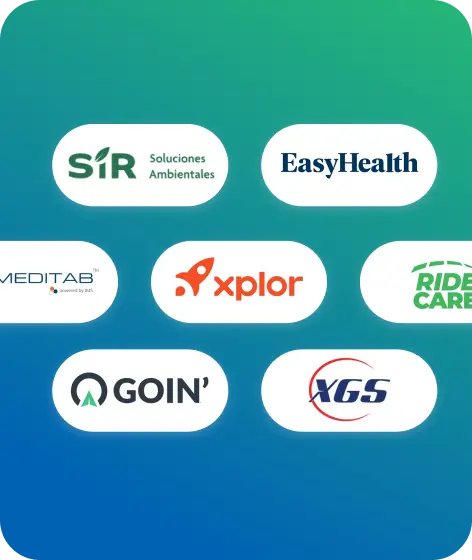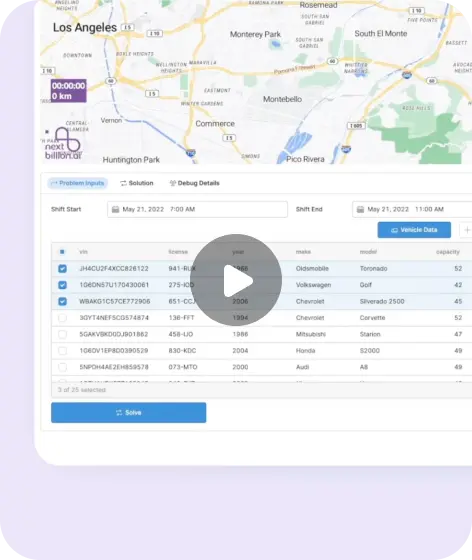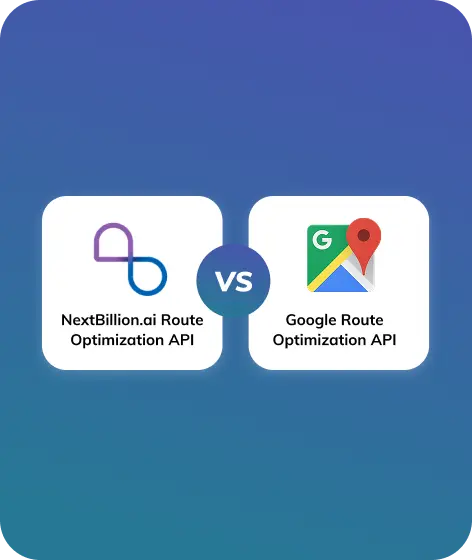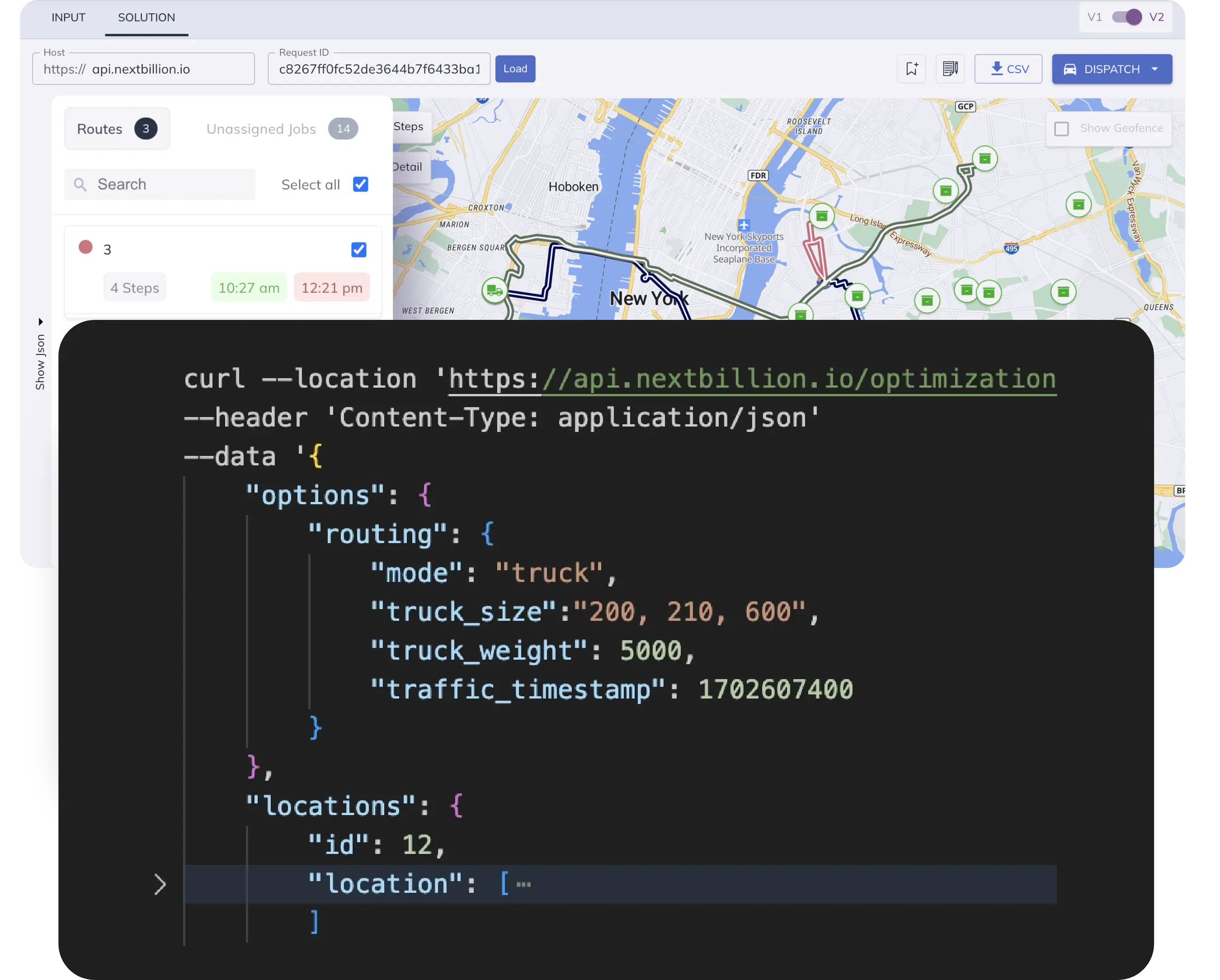Table of Contents
Selecting the right multi-itinerary optimization (MIO) platform can significantly impact your logistic business’s efficiency, cost savings, and overall performance.
As the logistics industry shifts away from Bing Maps, businesses are exploring alternatives to bridge the gap. Two leading contenders in these discussions are NextBillion.ai and Azure Maps.
NextBillion.ai and Azure Maps offer advanced routing capabilities, but which one is the best fit for your specific needs? To simplify the decision-making process, we’ve created a detailed comparison document outlining key functional features, helping logistic businesses to quickly determine which solution best fits their needs.
In this comparison, we break down their features, benefits, and key differences to help you decide.
Azure Maps Multi-Itinerary Optimization

Azure Maps Multi-Itinerary Optimization automates route planning for multi-agent and mixed-fleet operations. The process consists of two key steps: first, generating a distance matrix to calculate travel time and other associated costs between locations, and second, utilizing a solver (Nvidia CuOpt Service) to optimize routes for maximum efficiency.
The whole process involves two important aspects which are a must to ensure the route plan is generated efficiently.
Also Read: Alternative to Bing Maps Multi Itinerary Optimization API
NextBillion.ai Route Optimization API
NextBillion.ai’s Route Optimization API streamlines routing, task allocation, and dispatch, enhancing delivery efficiency and operational performance. It effectively addresses single and multi-vehicle route challenges, enabling faster deliveries, optimal resource utilization, and seamless scalability for businesses.
It offers multi-itinerary optimization, dynamic routing, geocoding, and map data management tailored to industry-specific needs. With its flexible APIs and seamless integration capabilities, NextBillion.ai empowers enterprises to enhance logistics, fleet management, and on-demand services with greater accuracy and efficiency.
Head-to-Head: Comparing the Features of NextBillion.ai and Azure Maps
When optimizing logistics, route planning, and mapping solutions, businesses often get confused between multiple platforms.
In this comparison, we’ll dive into the key features of NextBillion.ai and Azure Maps to help you determine which platform best aligns with your logistics requirements.
| Features | NextBillion.ai | Azure Maps |
| Integration Process | The platform streamlines the process with a single-step solution, integrating distance matrix calculation by default. | Azure Maps requires a two-step process, requiring integration with multiple vendors for complete functionality. |
| Route Matrix | It supports up to 5,000 unique locations in a single API call. | It supports up to 700 matrix cells, allowing itinerary planning for 26 locations, including depots and deliveries. |
| Route Geometry | It is generated by default in the output JSON of the optimizer, providing a complete view of the route for better planning and execution. | It does not include route geometry in the output JSON; the Azure Route Directions API is required to generate the route geometry. |
| Minimum Constraints per Vehicle | By default, cuOpt minimizes vehicle usage, but you can specify the number of vehicles to ensure all available vehicles are used. | The exact number of vehicles to use can not be specified, but the min-max tasks parameter helps distribute tasks evenly across available vehicles. |
| Minimum Vehicles | Optimizes fleet usage by assigning the fewest vehicles needed for efficiency. | This feature is not supported in Azure Maps. |
| Alternative Capacities | The platform has the ability to assign different capacity types to vehicles, allowing for more flexible and efficient load distribution. | It does not support this, leading to inefficiencies in load distribution as it can’t consider vehicle constraints like weight, volume, or special handling. |
| Speed Factor | It supports the speed factor, allowing for more accurate route optimization by factoring in varying speeds based on road conditions, traffic, and other relevant parameters. | It does not support the speed factor, limiting its ability to account for varying speeds due to road conditions, traffic, or other external factors when optimizing routes. |
| Hours of Service(HOS) | It supports route planning by factoring in layover times, rest periods, and driver shifts, ensuring realistic and compliant routing. | These maps cannot account for layover times, rest periods, or driver shifts during route optimization.
|
How NextBillion.ai Route Optimization APIs Stands Out Against Azure Maps?
Having explored the features of both NextBillion.ai and Azure Maps, let’s now take a closer look at why NextBillion.ai outshines Azure Maps.
Higher Location Capacity: NextBillion.ai supports up to 5,000 unique locations in a single API call, enabling more complex routing for large-scale operations.
Customizable Vehicle Allocation: NextBillion.ai allows precise control over vehicle allocation and optimization, enabling users to dictate how many vehicles should be used, ensuring better fleet management.
Tailored to Logistics: NextBillion.ai is specifically designed for logistics, offering advanced features like dynamic routing, fleet optimization, and real-time re-optimization based on traffic, weather, and other variables.
Advanced Optimization: NextBillion.ai supports multi-dimensional capacity planning and hybrid pricing models, allowing businesses to optimize routes while considering specific constraints like load types and fleet capabilities.
Scalable and Flexible: It provides flexible APIs that cater to a wide variety of business needs, making it a versatile choice for logistics, fleet management, and supply chain optimization.
Real-Time Updates: NextBillion.ai offers real-time dynamic re-optimization, which is crucial for handling unforeseen changes such as cancellations, traffic disruptions, or urgent tasks.
These benefits make NextBillion.ai a powerful solution for businesses requiring highly customized and scalable route optimization.
Conclusion: Making the Best Decision for Your Route Optimization Needs
NextBillion.ai and Azure Maps, both offer powerful multi-itinerary optimization solutions, but the choice ultimately depends on your business needs. NextBillion.ai stands out with its advanced optimization capabilities, handling larger datasets, providing more flexibility in vehicle allocation, and offering built-in route geometry generation, making it ideal for businesses seeking efficient, scalable, and customizable solutions.
By evaluating your specific requirements, such as route complexity, fleet size, and data handling needs, you can determine which platform aligns best with your goals for route optimization and operational efficiency.
To get more information, book a demo today!
Ready to get started?
Request a DemoTable of Contents





